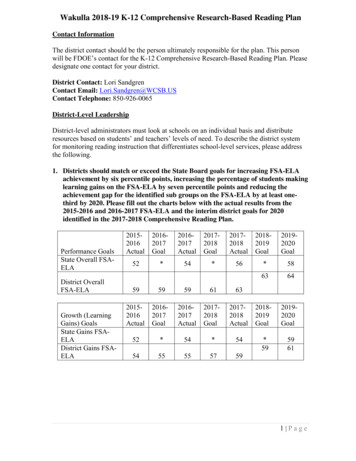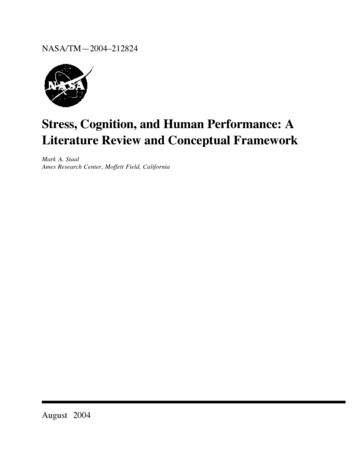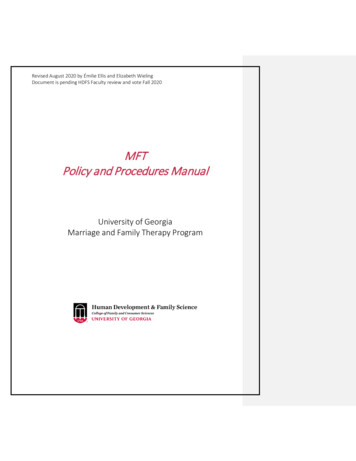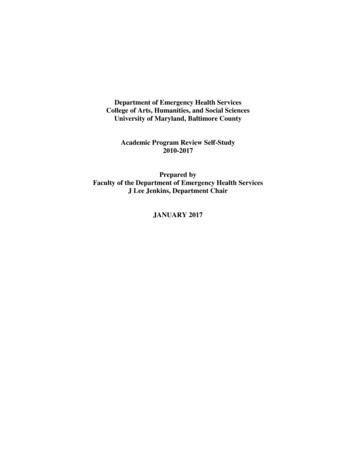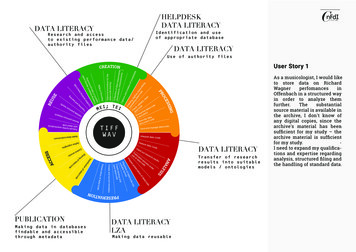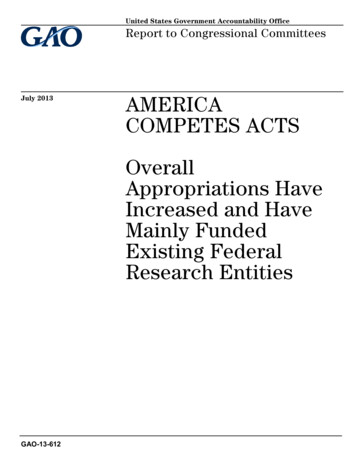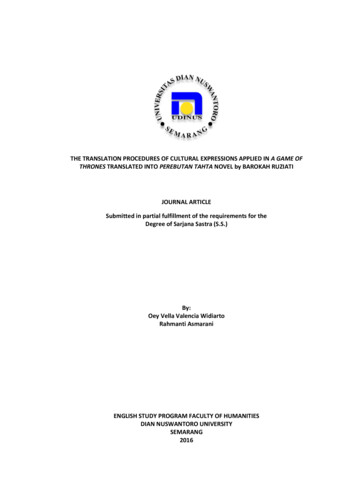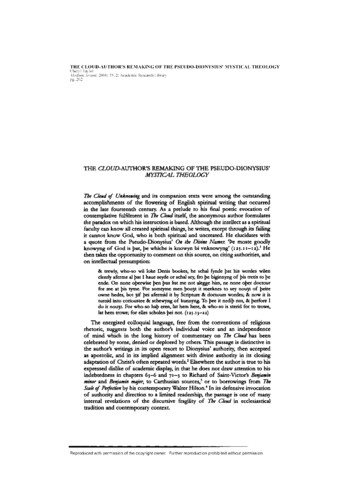
Transcription
THE CLOUD-AUTHOR'S RDIAKING OF THE PSEUDO-DIONYSillS' 'IYSTICAL THEOLOGYCh"nl Tu,lor.t/ diulJI.pg.2/)2(c!1'1I1J1.'2{)O(1: 75.2: /\cmkmic Rese n.'h Libn.lt")THE CLOUD-AUTHOR'S REMAKING OF THE PSEUDO-DIONYSIUS'MYSTICAL THEOLOGY'T'he C/olld of Unknowing and its companion texts were among the outstandingaccomplishments of the flowering of English spiritual writing that occurredin the late fourteenth century. As a prelude to his final poetic evocation ofcontemplative fulfilment in The Child itself, the anonymous author formulatesthe paradox on which his instruction is based. Although the intellect as a spiritualfaculty can know all created spiritual things. he writes, except through its failingit cannot know God, who is both spiritual and uncreated. He elucidates witha quote from the Pseudo-Dionysius' 0" the Dilline Namer: 'Pe moste goodlyknowyng of God is pat, pe whlche is knawyn hi vnknowyng' (up l-U),l Hethen takes the opportunity to comment on this source, on citing authorities, andon intellectual presumption:& trewly, who-so wil lake Denis bookes, he scha! fynde pat his wordes wilencleeriy aferme aI pat I haue seyde or scha! sey, fro Fe biginnyng of l is ttetis to l eende. On none operwise pen pus list me not a1egge him, ne none ope! doctourfot me at l is tyme. Fot somtyme men pou3t it meeknes to sey nou3t of peireowne bedes, bot 3if pci afermid it by Scripture & doctout8 wordes; & now it istumid into corioustee & schewyng of kunnyng. To i ee it nedil not, & perfore 1do i! nOU3t. For who-so hal eeen, !at hem here, & who-so is sterid for to trowe,!at hem trowe; for elles scholen pei not. (Uj.l3-21)The energized colloquial language, free from the conventions of religiousrhetoric, suggests both the author's individual voice and an independenceof mind which in the long history of commentary on The C/oNd has beencelebrated by some, denied or deplored by others. This passage is distinctive inthe author's writings in its open resort to Dionysius' authority, then acceptedas apostolic, and in its implied alignment with divine authority in its closingadaptation of Christ's often repeated words. 2 Elsewhere the author is true to hisexpressed dislike of academic display, in that he does not draw attention to hisindebtedness in chapters 6 -6 and 7l- to Richard of Saint-Vietor's BenjaminmiMr and Benjamin mtdor, to Carthusian sources,3 or to borrowings from ThtS(IJk of Peift(/;on by his contemporary Walter Hilton. 4 In its defensive invocationof authority and direction to a limited readership, the passage is one of manyinternal revelations of the discursive fragility of The Child in ecclesiasticaltradition and contemporary context.Reproduced with permission of the copyright owner. Further reproduction prohibited without permission.
THE CLOUD-AUTHOR'S REMAKING OF MYSTICAL THEOLOGY10 Such fragility is further suggested by the text's development, which ischaracterized by repetitions and fluctuations in rhetoric that sometimes indicateinterruptions to composition. 5 The author's offer to amend or amplify onrequest (1 O.14-I7) confirms that he did not seek to polish his longest treatiseto the structural perfection achieved in his formal epistles, Dim'elion of Slirringsand An Epistle oj Prtqer, which are the literary equivalents of costly manuscriptart. Instead the oral dialogues with his apprentice that seem to have inspiredThe Clolld and which permeate it as a textual strategy extend to an intertextualdialogue with Hilton. 6 Thus although the text solidified to the form familiar tolater generations at the point when manuscript transmission commenced, itsdetails probably remained conditional in its author's conception. In the sameempirical spirit he translated the Pseudo-Dionysius' Myslical Theology under thetitle of Deonise Hid Dillinite.7The Latin sources from which the author fashioned his translation wereselectively published, together with the Middle English text, in 1914 byAbbot Justin McCannB and again in 19n by Professor Phyllis Hodgson.McCann demonstrated that chapters 1-3 of Deonise Hid Dillinife, comprisingapproximately three-quarters of the text, are based on John Sarracenus' (JohnSarrazin's) Nova trans/alio (c. 11 67), while chapters 4-1 follow Thomas Gallus'Exfraclio or Paraphrase (u)8). Some conflation of these sources occurred, withthe further complications that the Extraclio is based on Sarracenus and that itmixes translation with exposition. 9 The editors traced further borrowings toGallus' Explanalio (C U41), a commentary on Sarracenus' version of the PseudoDionysius' canon, including the Mystical The%gy. HIThe source texts chosen by the Cloud-author represented major stages in theprocess by which the philosophy of the Pseudo-Dionysius came to influence thespiritual beliefs and practices of the western Church. Sarracenus' free renditionfound equivalent Latin terms for Greek vocabulary that John Scotus Eriugenahad retained in what became known as the Velus translalio, the first acceptableLatin translation of the canon, completed by 871. As a monk at Saint-Denis,Sarracenus helped to build a tradition of Parisian Pseudo-Dionysian scholarshipin which Gallus, a canon regular at the abbey of Saint-Victor, was to occupya 'prominent and distinct position'.ll Gallus' immersion in Pseudo-Dionysianthought over twenty years produced interpretations that blended scholarshipwith pastoral and contemplative concerns. 12 His commentaries were widelyread, and from the fourteenth century their manuscripts circulated in Carthusiancircles both on the Continent and in England. They were therefore a naturalsource for the Cloud-author when he came to compose the only known MiddleEnglish version of the Mystical Theology.Although Hodgson claims that Deonise Hid Diuinite 'follows its Latin sourcesclosely, with only very minor additions, omissions and modifications',n shelists these at length. She also notes the presence of 'more vivid imagery .often reminiscent of the lively language of The Cloutl 14 By contrast, in 1983Rosemary Ann Lees referred to the translation's 'comparative emancipation. apparent both in the flexibility with which it supplements and culls matterReproduced with permission of the copyright owner Further reproduction prohibited without permiSSion.
MEDIUM .vUMLXXY.lfrom its various sources as well as in the facility with which it seems in generalto preserve the native idiom of English prose'.15 She claims more contentiouslythat 'intelligibility seems in all things to have governed [the author's] practice asa translatOr'.16 My argument is that the small changes introduced by the CIoIiJ.author follow discernible trends. outlined below, and that even in this short textthey accumulate sufficient mass substantially to remake the sources. ] contendfurther that the author's procedures in Dtonirt Hid Dillinite were chosen so asactively to confirm his development of negative theology in The Ciolid.The prologue to Deonne Hid nillillite maintains the mixed pastoral anddefensive stance of the Ciolld passage quoted above:Ws writyng pat next folowep is pe Inglische of a book pat Seynte Denys wrotevnto Thimothe, pe whiche is clepid in Latyn tonge MiitWa Tbtolugia. Of pe whichebook, for-pi pat it is mad minde in 10 chapter of a book wretin before (llewhiche is clepid P, Chtuk oj V"hloMng) how pat Denis sentence wol c1eerlialferme at pat is wretyn in pat same book: i'erfore, in translacioun of it, I hauenot onliche folowed pc nakid lettre of pe text, bot for to declare pe hardnes ofit, I haue mache folowed tx: sentence of pe Abbot of Seinte Victore, a noble &a worpi expositout of pis same book. (:1. -lZ.)Two slippages suggest authorial anxiety. The first is that 'Denis baokes' inThe CIoNdhas become 'Denis sentence', a change that glosses over the adoptionof the MYslifal Theology as being fully representative of Dionysius' thought. 17 Theconnective 'Perfore' camouflages a second slippage. since the declaration thatthe author resorted to Gallus to clarify a difficult text does not follow logicallyfrom the contention that the MYstical Theowgy will clearly affirm every word ofTIH CIoNd. The author's uncharacteristic praise of Gallus may aim to defend hischoice of the Exlradio over Robert Grosseteste's commentary, which was basedon the Greek original. However the CWlld-author's assertion is more obviouslyaimed at defending his decision to combine his sources.As translator he in fact displays the same colloquial vigour and independencethat he demonstrates in the invented passages so far discussed. McCann, AlastairMinnis, and John Clark have considered how closdy the theology of Tht CloNd isaligned with Gallus' affective teachings. 18 However, Dtonis, Hid Diuinite is infusednot only with Gallus' 'sentence', but also with the doctrine and stylistic featuresof The Ciolld. The translation extends the sequence by which Sarracenus l9 andGallus in turn 20 adapted Dionysius' Greek Neoplatonism to Latin Christiandoctrine. Beyond this, the uniqueness of negative theology in the vernaculardevotional context of England in the 139 8 further explains why the authorshaped his version of the Mystifal TheowlJ so as to support The Ciolld.Many of the changes that he made are founded on his belief, alreadyexplained in The Child, that rather than the intellect or imagination, love is themeans by which the soul is united to God. 21 In emphasizing love's pre-eminencehe moderates Dionysius' philosophical abstractions by introducing affective,experiential, personal, and explanatory elements. These intrusions recaptureThe CIoIIJS presentation of contemplation as a vigorous human activity. Theauthor's reservations about learning and learned men are used to soften furtherReproduced with permission of the copyright owner. Further reproduction prohibited without permission.
THE CLOUD·AUTHOR'S REMAKING Of MYSTlCAL THEOLOGY:01the sOU1"Ces' intellectual language. However an exception occurs at the end,where Dionysius demonstrates the moment of the intellect's failing throughan exaggerated textuality which stretches language beyond its limits. Here theClolld-author extends the sources' linguistic overreaching to the point wherea silence eloquent with the divine mystery intervenes. In reapplying anothertechnique perfected in The Cloud,V. the translation thus mimes the surrenderin contemplation of the flow of thoughts to 'affecyon abouen mynde' (DeoniseHid Diuinite, 1. 2 f.).The author begins to diverge from his sources' scholarly status by translating'tbeologia', found in the titles of all surviving Latin versions, not by 'theologie',which by then was an accepted English word, but by the older Latin borrowing'diuinite'. Since 'diuinite' can mean either 'theology' or 'godhead'/J the Englishversion maintains an outward faithfulness to the original. However it imports thesuggestion that this work, like The Cloud, is 'A Book of Contemplacyon',24 thewords and structure of which will themselves assist the reader's practical effortsto attain knowledge of a God 'hidden' to the inteUect. A later mistranslationof Sarracenus' 'Theologiam' as 'Cristes diuinitee' (4.] 3) meaning 'divine nature',and an added reference to 'pis deuinite' (6.32) meaning 'contemplative method',further support this interpretation. In the same wayan address of the openingprayer to 'Wysdome', a concept favoured by Dionysius but often a portmanteauterm for contemplation,2s replaces the conventionally theological 'Trinitas',which again is found in all known Latin versions. Whereas Sarracenus gives theending as 'lgitur ista mihi quidem sint oratione postulata' ('Therefore may thesethings asked for in my prayer indeed be mine,), implying an exemplary function,the Cloud-author personalizes the opening with added first- and second-personpronouns: 'Pou vnbigonne & euerlastyng Wysdome' (1.14) . '/ beseche pee(2.17). He thus invites the reader to take part in the prayer.Deonise Hid Dillinite personalizes the divine to approximately the level reachedin The Cloud. Intruded personal pronouns continue to be applied to God,extending the effect achieved in the opening prayer (1,]9; ,.13; 5. 1; 7.18f.;7.;2-8.3). Additions of 'hym', 'himself' and an insertion to the effect that thetrue understanding should be held by faith ('fastliche for to holde in si3t ofbyleue,) qualify the abstraction of Dionysius' thought about the primal cause(4.3-10). Two references to Christ are also added (4.13). Where Sarracenuswrites: 'quomodo divina et bona natura singularis didtur', the translationretains Anglicized forms of the adjectives, but undermines their abstractionwith an Anglo-Saxon noun and definitions: 'how pat hi3e, deuine synguleerkynde, pe whiche is God, is one' (7.14f.). By preferring Gallus' Extraf/io overSarracenus, the conclusion to chapter 3 replaces non-personal with personalconstructions. 26 However in a contrary procedure in chapter . based on Gallus,God is referred to as 'he' following Sarracenus, in preference to Gallus' 'omniumcausa' (9.26).21Furthermore, the first of a series of interpolated references to 'affeccyon'as a supra-rational faculty for apprehending the divine expands Sarracenus'conclusion to the prayer quoted above, so that it reads as follows: 'And for alleReproduced with permission of the copyright owner. Further reproduction prohibited without permission.
MEDIUM ' VUMpees pinges ben abouen mynde, perfore wip affeccyon abouen mynde as I may, Idesire to purchase hem vnto me wip pis preier' (1,Z5-7). The expansion imposeson the source a proposition that the author had explored empirically in The Child,namely that a mind focused on God's substance operates above the ordinaryhuman level (rzo.z-8). By touching on the theme of longing also recurrent inThe Cloud,28 it grounds in the reader's desire the paradoxical abstractions ofDionysius' address to a divinity opaque to intellectual seeking.While the interpolations involving 'affeccyon' are confined to the long firstchapter of the CloNd-author's translation, which is mostly based on Sarracenus,they have the effect of extending Gallus' doctrinal influence in the form in whichit already appears in the affective focus of The Cloud. However, only one of theinterpolations (j.l j) dtaws on Gallus' writings as a direct source, and even herehis equivalent word is 'dilectio'.29 The author therefore appears to be actingindependently in giving prominence to 'affeccyon'. In Tht CloNdhis chosen termfor the faculty by which God may be 'getyn & holden'is 'loue' (z6.4f.),311 meaningthe soul's will and power to love (18.lj-zo). However by the time of writing'affeccyon' was thoroughly acclimatized in English devotional texts including ThtClOlld,31 and the author's preference in Deollisl Hid DiNillite for 'affeccyon' is thusa relatively minor concession to Sartacenus' abstract Latin vocabulary and thestatus of the Nova Irallsiatio as theology. Moreover the interpolated references to'affeccyon' are a technique of emotional enrichment appropriate to the Ciolldauthor's practical contemplative purpose and to his recognition in The Cloud thatthe 'swetnes of loue' (46.18) is also a feeling: 'pe felyng of pis is eend1es blisse'(19.13). In Deollise Hid ViNillite a later pair of examples expands the description,'munde . cuncta auferens et a cunctis absolutus', with an acknowledgement ofhuman complexity: 'makyng piself clene fro al wordly, fleschly, & kyndely Iikyngin pin affeccioun' (3-14 .). This prepares for the contemplative reader's againbeing 'drawen up abouen mynde in affeccioun' (301M.) to the divine darkness.Two inal insertions of 'aff'eccioun' (4.2" ,.q) likewise relate to contemplativepractice rather than to theory.The drift to an experiential orientation in Deonise Hid DiNillite is con irmedby the opening to chapter I. Here, in an expansion unparalleled in Sarracenusor Gallus, the author ictionalizes Timothy's and the reader's state at thecommencement of contemplative practice: 'what tyme pat pou purposist pee bype steryng of grace to pe actueel excersise of pi blynde beholclynges' (z.;lf.).The Clouds focus on the novice's preliminary progress in chapters 1 and Z iscomparable. A parallel resort to narrative occurs in an introduction added inDeollise Hid DiNillite to Sarracenus' account of Moses on Sinai: 'Ensaumple ofpis se by pe story how . '(4.17). An interpolated reminder of context likewiserecalls the development of this narrative, based on Benjamin m,yor, in the climaxto The Cloud: 'In pis tyme it was pat Moyses in syngulertee of affeccioun wasdepartid from pees beforeseyde chosen preestes'f.). Moses' separation isnot referred to in the soutces,32 but recalls contrasts in The CloNd among Moses,Bezaleel, and Aaron as priest. Chapter I of the translation concludes by againinvoking a dimension of the contemplative's affective experience that goes(,.1,Reproduced with permission of the copyright owner. Further reproduction prohibited without permission.
THE CLOUlJ.AUTHOR'S REMAKING OF MYSTICAL THEOLOGY207beyond Sarracenus, whose difficult Latin the author partly mistranslates in away that rules out pantheistic implications: 'for to fele in experience e presenceof hym pat is abouen alIe pinges, not hauyng felyng ne pinkyng of no beyngping' (l.19-ZI).3]Again, when the author describes the ascent to transcendence as occurring'somtyme sodeyner pen oper' (8.19), he recaptures The Clolliis interest in theduration of contemplation. 34 Among other experiential additions reminiscentof The Cloud is his exhortation that as well as 'strange' (Sarracenus 'forti).contrition should be 'slei3' and 'listi' (3.1). 'Slei3' and its cognate 'sld3t' (referringto the strategic working of grace) are interpolated again later, also in relationto contemplation (6.2.7, 6.2.6). First recorded in English in The Cloud, 'listi' and'listely' designate enthusiasm for spiritual practice.3S Together 'slei3' and 'listi'denote an eagerness tempered by wisdom, and in The Cloud they encompass thenotion of contemplation as play. This nexus recurs over several chapters 36 andincludes an explanation of the significance for contemplation of the proverb,'wirche more wip a list pen wip any liper strengpe' (87.6f.).37 Deonise HidDiuinife therefore qualifies the Latin text's recommendation of strength with thesagacious easeful approach evoked by the language of The Cloud.Further psychological and theological modifications recapture features ofThe Cloud. The author's reiterated distinction in the earlier work between 'bodilywittes' and 'goosdy wittes' is used to extend Sarracenus' generalized allusionsto physical perception. The translation adds a definition of 'bodily wittes': 'asheryng, seyng, smelling, taastyng, & touching' (3.2.), and specifies separate areasof operation for the bodily and spiritual senses: 'alle poo pinges, pe whichemowe be knowen wip any of i fyue bodeJy wittes without-forpe; and alle poopinges pe whiche mow be knowen by pi goostly wittes wipinne-forp' (3.3-6). Anadded dismissal of those 'wonyng 3it not only in here goostly wittes of naturedphilosophy, bot lowe downe bynepe in here bodily wittes, pe whiche ei hauenbot in comoun with only beestes' (}.2.7-30) recalls the satiric cameos in The Cloudof misguided contemplatives who mistake bodily feelings for spiritual working(chapters P-3). Finally, Deonise Hid Diuinile modifies Sarracenus' representationof Dionysius' theology with intruded references to grace,J8 a doctrine which, inaccordance with Augustinian tradition, including Gallus, pervades The Cloud.In yet another significant parallel to The Cloud, where the author createsrecognizable identities for himself and his disciple, Deonise Hid Diuinilestrengthens the sense of a speaker and a hearer for its message. Authorial firstperson pronouns are introduced in such phrases as 'I beseche ee' (1.17); 'asI may' (1. 16); and 'I haue affermyngliche set' (7.19). Where Sarracenus reads'quid dicat quidem aliquis?', the translation personalizes to: 'what schul /lie seypan . ? (3.2.7). Gallus' 'removetur ab eo' in the Extraclio similarly becomes'we schuld do awey from hym' (B.n). As reader's representative, the apostleTimothy is actualized in the opening by intruded second-person pronouns39and by translating Sarracenus' adverb 'ignote' as 'in a maner at is pou wosteneuer how' (3.1 1). This parallels such phrases in The Cloud as 'pou wost not how'(16.14) and 'pou wost neuer what' (17.1), and alludes to the earlier work's manyReproduced with permission of the copyright owner Further reproduction prohibited without permission
208MEDIUM LEVUMLXXV.:evocations of the desired contemplative state of unknowing. Again, TbI CIoNdconstructs the author and disciple as fellow contemplatives: 'sipen we ben bopeclepid of God to worche in pis werk' (1Z9.lof.). Dtonis, Hid DiNinil, recreatesthis relationship in two interpolations: 'as it is possible to me for te speke & topee to vnderstonde, loke pat pou rise wip me in pis grace' (3.9; Sarracenus: 'sicutest possibile, ignote consurge')j and 'us alle pat ben practisers of pis deuinite'(6.31; no Latin parallel).Th, CiONd survives in the twenty-first century as a guide to contemplationbecause of the subdety and practicality of its teaching. The vernacularassertiveness that distinguishes it as text in its Middle English setting40 erupts inDtonul Hid Dim"ill in the form of oppositions: 'It is noping pus: bot pus mostit be' (4.1; no Latin equivalent); 'not to alle, bot to hem only' (4.2.of.; Sarracenus:'his qui'). It also takes the form of emphases: 'Fe whiche in himself is abouenalle, 3d bope doyng awey and alfermyng of hem alle' (4.lof.: Sarracenus: 'quaeest super omnem ablationem et positionem'). Similarly, the author augmentsthe Exlradio by adding energetic repetitions of 'al' to the list of bodily thingsto be taken away in the effort to conceptualize the divine nature (9.15-2.0). Thisstrategy enlarges his vivid demonstration in The CIoNd that 'n03 where boddyis euerywhere goosdy', a proposition to be experienced as true by those whorenounce the intervention of the senses in spiritual working (I U .1 S-2.1). Arelated interpolation articulates his prejudice against those who create figuresof God and spiritual things 'in here fanwtik ymagynatyue wittes' {3.H).·tThe author's vigour of utterance sometimes takes the form of removingqualifications. He translates as superlatives a series of Latin comparativesdesignating spiritual things close to God (8.10, [7. 18,2.3,14, 27). and excisesmodest implications of doubt: 'betokenip' translates Sarracenus' 'hoc autemputo significare' (S .6) and his 'sicut arbitror' is omitted (6.11).Commentators have noted The CIONt/S use of vivid physical imagery.42However Th, CIoNd also seeks to negate the physical associative properties ofthe metaphors that it applies to God and contemplation by upholding theirfigurative status: '& wene not, for I depe it a derknes or a cloude. at it be anycloude congelid of pe humours pat Been in pe ayre, ne 3it any derknes soche asis in l in house on ni3tes, when pi candel is oute' (11.13-J 5). This same tensionpersists in Deonm Hid DiNinill in interpolated figures and analogies that alternatewith efforts to limit or thwart the imagination. Among the interpolated imagesis a simile, 'as pc lady hap hir maydens' (S.8), that was domesticated in the Glolldgroup by the translated allegory of Jacob's wives and their handmaids in Benjaminminor. In Dtonist Hid DiNinill it further elucidates the subordination of theintellect in contemplation. Supplementary kinaesthetic metaphors of drawingup, fastening, and foldingO likewise recall the exposition of contemplation asan energetic human work in The CIoNd, where each of these actions conveys anaspect of practice or experience.""The most substantial remaking of sources in Deonnl Hid Dillinill is theauthor's treatment of Dionysius' brief sculpting analogy. This is translatedby Sarracenus and slightly expanded in Gallus. The CloNa'-author's alternatingReproduced with permission of the copyright owner. Further reproduction prohibited without permission.
THE CLOUD-AUTHOR'S REMAKING OF MYillCAL THEOLOGYaugmentation and undercutting of figures relating to contemplation adapts theanalogy to the teaching and vocahulary of The Cloud, while again theorizing adistrust of the intellect as a faculty for approaching uncreated bc:ing.As elsewhere, the English text initially inflates the likeness with experientialdetails. The 'facientes' and 'artifices' in Sarracenus and Gallus are replaced hya situation and a character: 'Here is a man hauyng a sounde stok of i'e grettestquantitee wipoutyn hym, liing before hym, and hauyng wii'inne hym entent . '(S.B ). The inner-outer balance thus established persists through a psychodrama, invented by the author, of uncovering the divine image at the centreof the block. Details of the artist's preliminary imaginative grasp of the imageare added. The analogy describes how he finds the centre by 'mesuryng ofri3t lynyng' (6.4), and the 'craft' and 'instrumentes' that he uses to carve awaythe obscuring wood (6.7)' The changes again encompass The Ciol/tis view ofcontemplation as a 'werk', while the adapted analogy's fusing of the artist'simagination with the physical world recaptures yet another emphasis of TheCloud, where this fusing is seen as a cause of erroneous working (94.2.4-4).Therefore it is not surprising that the author proceeds to undermine theimaginative analogy at the point of application: 'Ri3t so we must haue us in i'ishi3e deuyne werk, as it is possible to be comyn to in vnderstondyng by soche aboistous ensaumple of so contrary a kynde' (6.9-1 I).After thus rejecting the bodily 'ensaumple' suggested by his sources, theauthor provides an alternative spiritualized analogy. This begins with a lucidevocation, unparalleled in Sarracenus or Gallus, of the divine 'kynde' hidden atthe centre of the block. In re-creating this central Dionysian conception, theAnglo-Saxon words retain paradox as an anti-intellectual device, while avoidingthe abstract Latinity typical of the sources:pof it be in itself & to itself euermore free - wipinne aile creatures, not inclusid;wipouten aile creatures, not schit oute; abouen aile creatures, not bome up;binere alle creatures, not put doun; behynde aile creatures, not put bak; beforeaile creatures, not dreuen farre - (6.1 -17)However these terms too are revealed to be inadequate, since the divineimage cannot be grasped by an embodied understanding (6.18f.), in which it isoverlaid and obstructed,wip vnnoumerable sensible bodies & vnderstondable substaunces, wip many amerueilous fantastik ymage, conielid as it were in a kumbros clog abouten hym,as pe ymage of pe ensaumple wretyn before is hid in pe pik. greet, sounde stok.(6.10-4)This culminating redefining of the block as the complex faculties of bodyand mind affirms yet again the deceptiveness of the imagination and the bodilyfigures that it creates.Earlier DeQnise Hid Diuinite had dismissed those who seek to reach the firstcause 'hi making of figures of i'e last and pe leest wori'i i'inges of i'ees beyngvisible pinges, as stockes or stones . ' (H4 ).This dismissal foreshadows thetranslator's rejection of his sources' analogy as a deceptive product of theReproduced with permission of the copyright owner Further reproduction prohibited without permission
MEDIUM iEVUMLXXY.lbodily imagination. The dismissal's concluding phrase, equivalent to 'scilicetlapidibus et metallis' in the Exlradio, is conventionally applied in Middle Englishto the worship of false godS.45 These additional negative resonances persist inthe analogy's construction and reconstruction ('.H, 6.z), which emphasize thephysicality of the ' e pik, greet, sounde stok'. For example, the remade analogyreplaces Sarracenus' image, 'circumvelatum' {'veiled about'; Gallus: 'latentwnsub misticis vellS}. with 'wallid aboute' (7.6). Furthermore, the analogy's finaldisparagement of the 'stok' as 'a kumbrous clog' of thoughts and images alignsit with the congealed 'lump' in The Cl6l1a of all sins together, 'none oper pingpan pi-self' (73.17f.).-46Ikonise Hid Dimn;1t further adjusts the reconstructed analogy to contemplativepractice by a first-person application of The CI6I1t1s teaching and an infusion ofits terms: 'For we moten be in is werle as it were men makyng an ymage of hisnaltfyd, vnmaad, & vnbigonne kynde . .' (6.uf.);·1 and 'pe whiche koumbrousdogge . we moten algates craftely pace awey by sleiJ! oj grlUe in is deuine tlJerle'(6.Z4-6).018 Ineffability and practicality remain paramount to the end: 'in a manerpat is voknowen how voto alle, bot only to poo pat it prouep; and 3it euermoreto 1 00 same, bot onliche in tyme of pe proef' (6.z9'-31). These assertionspatallel the final chapters of The CioNd, which stress the incommunicability offulfilled contemplation, ,.,is nou3t when it is nou3where wrou3t' (uz.lsf.). andcaution against the mistake of judging others' experience by one's own (chapter7z).Outside the analogy, other modifications in DlOnise Hid DiNinile focus onthe limits of the intellect's attainment in contemplation. They thus recapitulatea message delivered empirically and theoretically in The CI6Nd. For example, aninterpolated clause defines 'swnmitatem divinarum ascensionum' as 'pc teermes& pc boundes of mans vnderstondyng, be it neuer so holpen wip grace' (pf.).Again, the translation re-emphasizes God's transcendence 'of alle vnderstondablepinges . & aIle vnderstondyng' (8.z f.) with a vigorous added (omplexio: 'And3it he in hymse1f is abouen bope aile spekyng and aIle vndentondyng' (8.34f.).Like The CI6Nd.49 Deon;se Hid DiNinilt supports the view that God is beyond 'allespekyng' by attending to the threshold where the intellect, and with it languageas the mediator of concepts, fails. Sarracenus describes the state beyond thisthreshold as 'non sermonum brevitatem. sed irrationabilitatem petfectarn etimprudentiam'. The author strengthens this by tr
THE CLOUD-AUTHOR'S RDIAKING OF THE PSEUDO-DIONYSillS' 'IYSTICAL THEOLOGY Ch"nl Tu,lor .t/ diulJI. (c!1'1I1J1.' 2{)O(1: 75.2: /\cmkmic Rese n.'h Libn.lt") pg.2/)2 THE CLOUD-AUTHOR'S REMAKING OF THE PSEUDO-DIONYSIUS' MYSTICAL THEOLOGY 'T'he C/olld of Unknowing and its companion texts were among the outstanding accomplishments of the flowering of English spiritual writing that occurred
